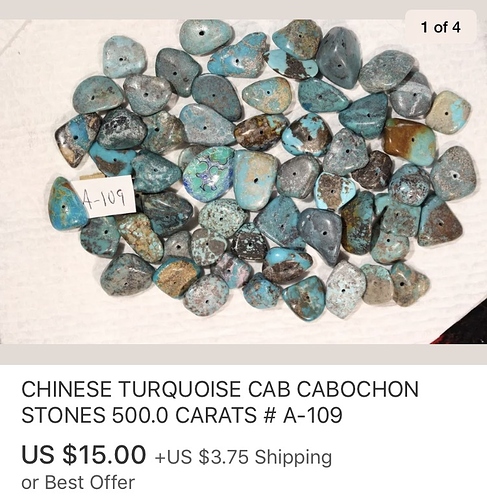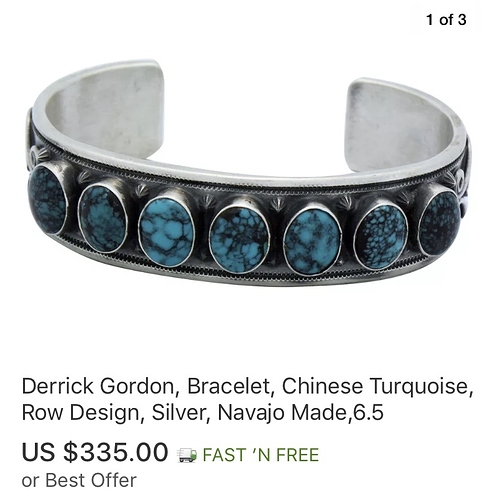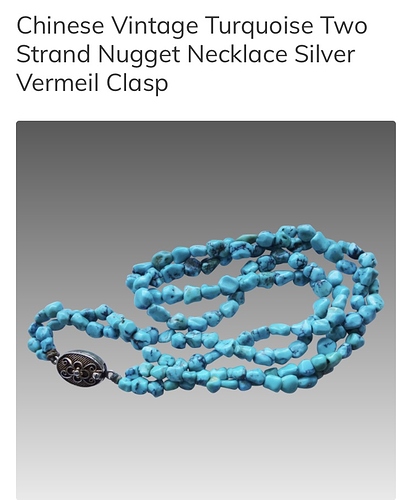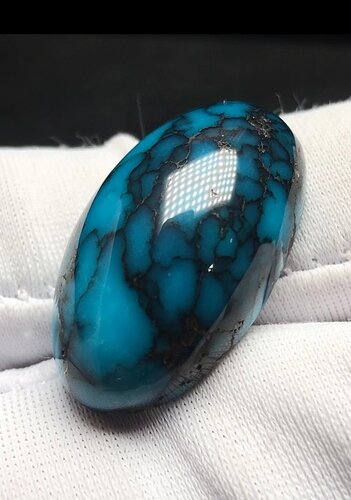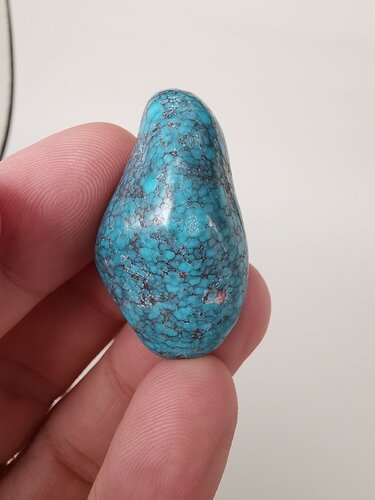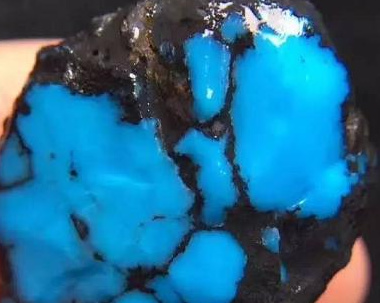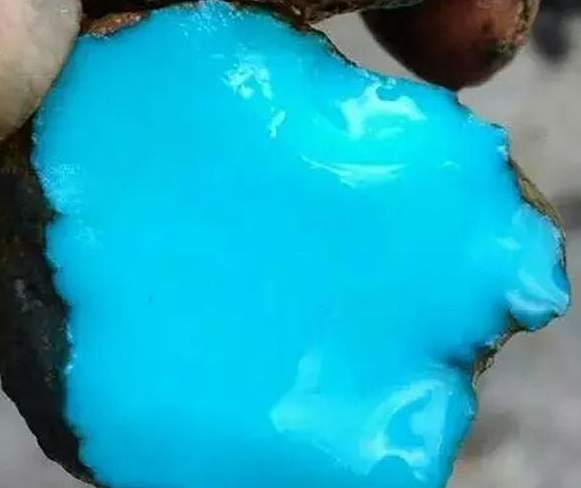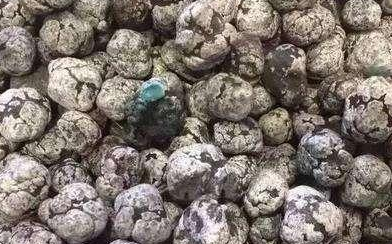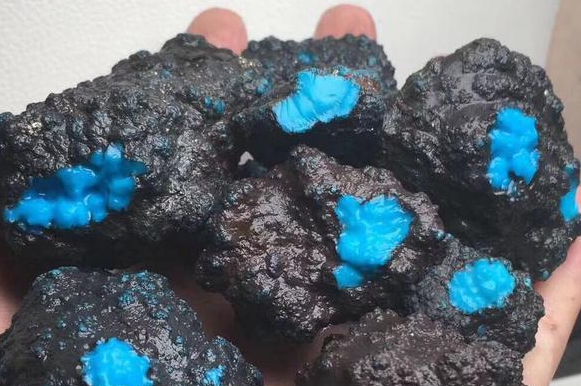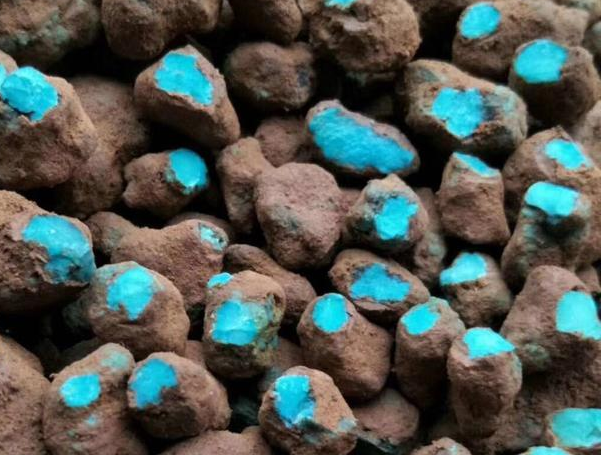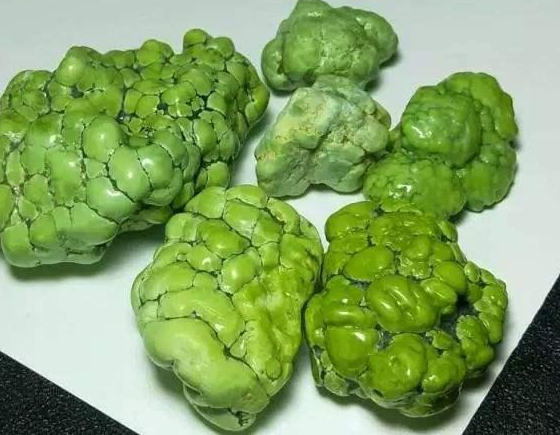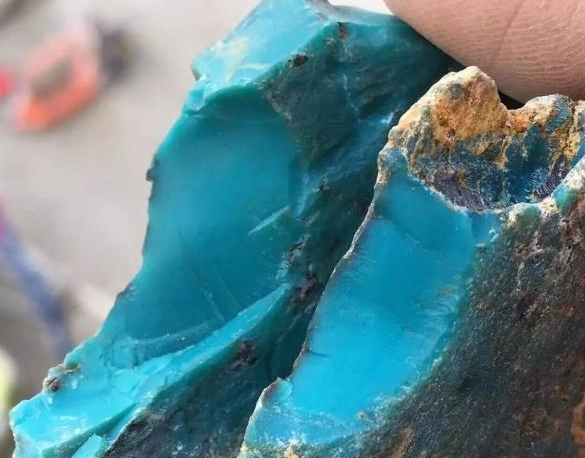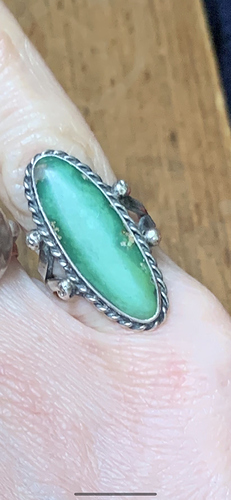I have seen a number of posts here where someone will post their turquoise cabs, beads or jewelry, only to be immediately disappointed when The Turquoise People arrive at the consensus that the posted item is Asian. But fear not! I decided to write this (very long) post because I feel that many people believe that because their turquoise is Asian, that it is automatically “junk.” This is not always true! The aim of this post is to debunk the myth behind Chinese turquoise, and to raise awareness when purchasing it. WARING: this post is very, very long
A quick introduction:
According to Durango Silver Company, "Chinese turquoise accounts for over 60% of the stones sold in the United States, due to the scarcity of American turquoise. Chinese turquoise can be just as beautiful as American turquoise, “In fact, China seemed to produce the highest amount of spiderweb turquoise thus far. Some of the high-grade Chinese turquoise resembles and is thought to be equal to many of the better known or classic American Southwestern mines” (Durango Silver Company). Chinese turquoise is sometimes mistaken for Royston, Kingman, Bisbee, and more because of the massive variations in color and matrix. But, unlike American turquoise that can usually be attributed to a specific mine, Chinese turquoise is usually just referred to as “Chinese Turquoise”. Most of China’s turquoise is mined from the Hubei Province and from the Ma’anshan Mine near Shanghai.
To begin, here are some user-posted examples of Asian turquoise. Chinese turquoise usually exemplifies an intricate matrix; here is a magnificent piece of Asian spiderwebbed turquoise that is owned by Turquoise People member @bartleby
And a charming Chinese bead with very faint water webbing posted by user @patrick
Now, why is it that if Chinese turquoise rivals the quality and beauty of some famous American turquoise mines, why is it seen as “cheap?”
Well for one, China runs things a little differently. Environmental regulations, labor laws and safety codes are not well regulated like they are in the states. That translates to low costs to mine, process, cut and export turquoise. Some Chinese turquoise can be bought for as little as $1 per carat, sometimes less. It is no secret that Americans often associate Chinese products with low prices and inferior quality.
PuebloDirect.com also gives us an alternative perspective, explaining why Chinese turquoise is often looked down upon, saying:
“In the mid-1980s when Chinese turquoise started coming to the US market in large quantities, unscrupulous dealers would often sell Chinese turquoise as Number 8, Lander Blue or many other famous mines, asking for the much higher prices commanded by these American counterparts. This practice greatly hurt the image of Chinese turquoise, and still puts off potential buyers today even when labeled correctly.”
Hence, Chinese turquoise has been less desirable due to it being fraudulently sold as American turquoise, along with the lower costs associated with the stone. There is nothing wrong with purchasing Chinese turquoise, so long as you are paying Chinese turquoise prices. It is fraudulent and disheartening to pay Lander Blue turquoise prices, only to discover you were sold Chinese turquoise.
Here is a large Hubei (Chinese) turquoise cabochon being sold online. It’s easy to see how it could be mistaken for (or sold as) American spiderweb. Durango Silver Company has this cab listed an astounding $740.
With that being said, be weary when you are purchasing Chinese turquoise!
Although I highly praise GENUINE Chinese turquoise, there are people out there who intentionally aim to deceive buyers. John Hartman created a good check list for purchasing turquoise:
1.) Make certain the person or business you are dealing with is reputable and they have been in business long enough to know their business.
Always check customer reviews when available. Scrupulously inspect pictures and items, do not be afraid to ask questions! If anything about the product raises a red flag, do not be afraid to WALK AWAY. Check out these listings from AliExpress.com; all of these beads are described as “turquoise,” when in fact, these are all dyed substitute stones. Listing #4 is especially deceiving:
2.) Make certain the Native American Jewelry you are purchasing was “Made in the USA” and is made with Sterling Silver and authentic Turquoise.
As stated earlier, China’s export rules are not as well regulated. The term “turquoise” is often purposefully used to describe dyed magnesite, dyed howlite or other substitutes. This is intentionally meant to deceive buyers. Faux turquoise can also be created entirely from composite material and dyes.
3.) Beware of “Indian Traders” or any business that offer deals that are too good to be true. Know that sterling silver currently averages $16 per ounce and authentic Turquoise values have went through the roof in the past years. If Indian Traders or businesses are offering 50% off or super bargains - it is guaranteed they are trying to get rid of their inferior products or trash - LOOK OUT!
I personally have been a victim of false advertising a few times. I have purchased rings from china that are CLEARLY marked .925 and within a week my finger turned green. If it’s too good to be true, than it probably is! Check out this “deal” from jtv.com:
The ring is advertised as Sleeping Beauty turquoise, but the ring band clearly says CHINA! Although this ring is likely to be sterling, it is meant to deceive buyers into thinking that they are buying a southwestern turquoise ring at clearance price.
Now, here’s the good news about Asian turquoise:
Vintage and antique Asian turquoise values have skyrocketed in the last few years! Check out some of these examples:
•Here’s a modern, Navajo-made cuff with Chinese spiderweb turquoise:
•These vintage bead strands from 1940’s have a very Native American- like influence to them. They almost resemble strands of Sleeping Beauty turquoise! The RubyLane.com asking price is $300.
•And lastly, these simple and chíc vintage hand-knotted nugget beads from the 1950’s.
Can Chinese turquoise really command these prices? YES!
Chinese tourism in America has boomed within the past two years. In my antique store, I noticed MANY Asian tour groups coming in and purchasing any Chinese antiques (including antique/vintage turquoise) that they could find. I finally asked one of them what the deal was.
As it turns out, it is punishable by law to export any antique or vintage items out of China! So many Chinese treasures have been destroyed over the years due to various ruling regimes, that the market is starving to purchase back any Chinese treasures they can find here in the states to bring them back to their homeland. Vintage/antique Chinese turquoise is very popular with Chinese tourists right now, it is hard to keep it in stock.
This is the end of my long rant about Chinese turquoise. There is amazing, high quality Chinese turquoise out there that can be very valuable. But on that note, please be cautious when purchasing. There are so many fakes and imitations out there… the only remedy for which is studying and physically handling turquoise to get that hands-on experience. I write this in hopes that the next time you encounter a piece of Chinese turquoise, that you give it a second chance and examine it again. You might have a hidden treasure!
If this post was useful to you, or you found some discrepancies with my statements, please let me know in the comments! I would love to hear your opinions on Chinese turquoise.
-BigBree43
